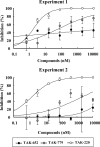Isolation and characterization of human immunodeficiency virus type 1 resistant to the small-molecule CCR5 antagonist TAK-652
- PMID: 17116673
- PMCID: PMC1797735
- DOI: 10.1128/AAC.01079-06
Isolation and characterization of human immunodeficiency virus type 1 resistant to the small-molecule CCR5 antagonist TAK-652
Abstract
TAK-652, a novel small-molecule chemokine receptor antagonist, is a highly potent and selective inhibitor of CCR5-using (R5) human immunodeficiency virus type 1 (HIV-1) replication in vitro. Since TAK-652 is orally bioavailable and has favorable pharmacokinetic profiles in humans, it is considered a promising candidate for an entry inhibitor of HIV-1. To investigate the resistance to TAK-652, peripheral blood mononuclear cells were infected with the R5 HIV-1 primary isolate KK and passaged in the presence of escalating concentrations of the compound for more than 1 year. After 67 weeks of cultivation, the escape virus emerged even in the presence of a high concentration of TAK-652. This virus displayed more than 200,000-fold resistance to TAK-652 compared with the wild type. The escape virus appeared to have cross-resistance to the structurally related compound TAK-779 but retained full susceptibility to TAK-220, which is from a different class of CCR5 antagonists. Furthermore, the escape virus was unable to use CXCR4 as a coreceptor. Analysis for Env amino acid sequences of escape viruses at certain points of passage revealed that amino acid changes accumulated with an increasing number of passages. Several amino acid changes not only in the V3 region but also in other Env regions seemed to be required for R5 HIV-1 to acquire complete resistance to TAK-652.
Figures





References
-
- Baba, M. 2006. Recent advances of CCR5 antagonists. Curr. Opin. HIV AIDS 1:367-372. - PubMed
-
- Baba, M., O. Nishimura, N. Kanzaki, M. Okamoto, H. Sawada, Y. Iizawa, M. Shiraishi, Y. Aramaki, K. Okonogi, Y. Ogawa, K. Meguro, and M. Fujino. 1999. A small-molecule, nonpeptide CCR5 antagonist with highly potent and selective anti-HIV-1 activity. Proc. Natl. Acad. Sci. USA 96:5698-5703. - PMC - PubMed
-
- Berger, E. A., P. M. Murphy, and J. M. Farber. 1999. Chemokine receptors as HIV-1 coreceptors: roles in viral entry, tropism, and disease. Annu. Rev. Immunol. 17:657-700. - PubMed
Publication types
MeSH terms
Substances
LinkOut - more resources
Full Text Sources
Medical
Miscellaneous

